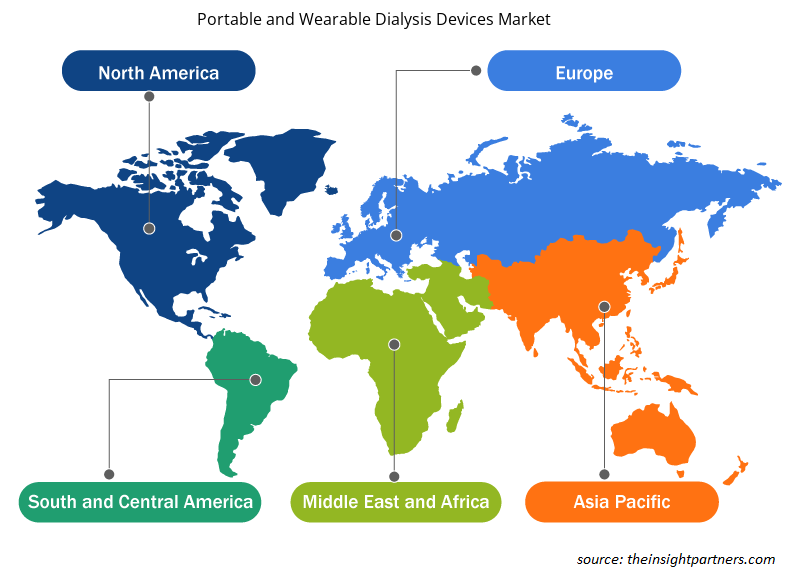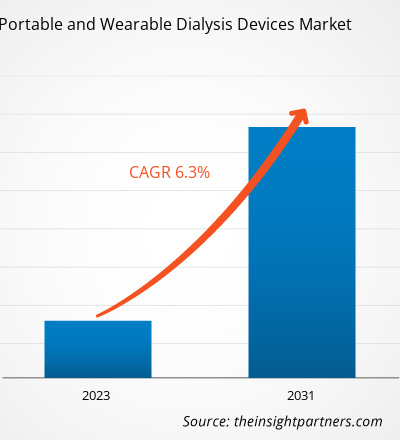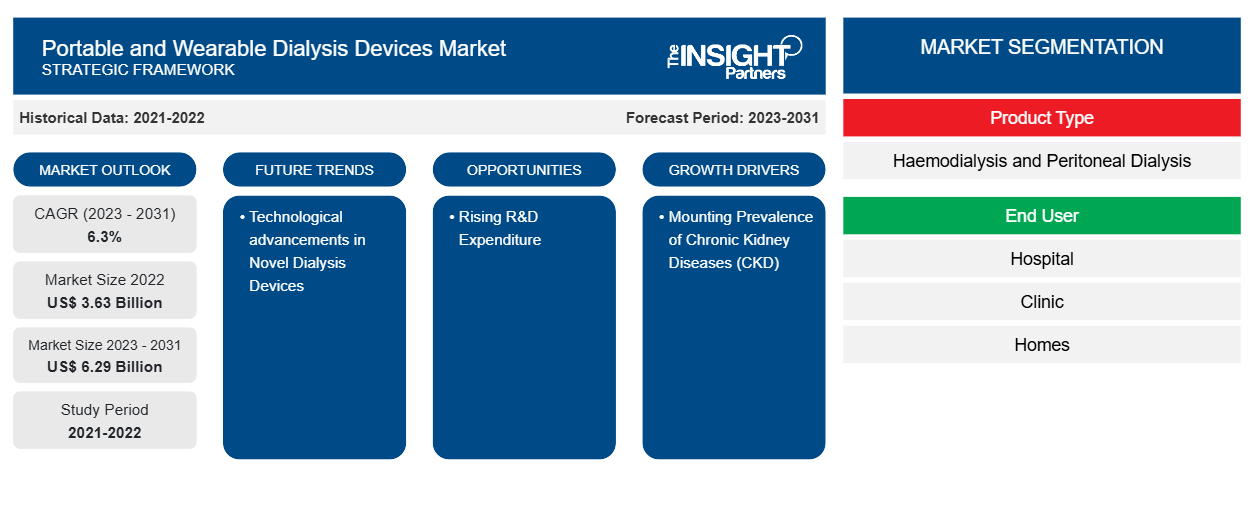便携式和可穿戴透析设备市场规模预计将从 2022 年的 36.3 亿美元增至 2031 年的 62.9 亿美元。预计 2023-2031 年市场复合年增长率将达到 6.3%。新型透析设备的技术进步很可能仍是便携式和可穿戴透析设备市场的一个关键趋势。
便携式和可穿戴透析设备市场分析
肾透析设备用于治疗患有慢性肾病的患者。该设备包括一个透析器,当肾脏无法充分发挥其功能时,它可以过滤掉废物以及多余的血液。新兴的便携式透析设备提供了新一代设备,可以为肾衰竭患者提供更多选择,让他们能够在家中接受即时治疗。终末期肾病患者的数量不断增加,器官捐赠者的数量有限,预计将有利于新型便携式和可穿戴设备的开发。
便携式和可穿戴透析设备市场概况
美国肾脏基金会指出,2020 年美国有 22,817 人接受了肾脏移植;然而,仍有超过 100,000 名美国人在等待肾脏移植。大多数等待肾脏移植的患者每周要接受多次漫长而繁琐的透析治疗。肾脏捐赠者数量有限,这促使人们开始采用和认识可穿戴和便携式设备来治疗终末期肾病 (ESKD)。
定制此报告以满足您的需求
您可以免费定制任何报告,包括本报告的部分内容、国家级分析、Excel 数据包,以及为初创企业和大学提供优惠和折扣
- 获取此报告的关键市场趋势。这个免费样品将包括数据分析,从市场趋势到估计和预测。
便携式和可穿戴透析设备市场驱动因素和机遇
慢性肾脏病(CKD)患病率不断上升,利好市场
CKD 与心脏病和 ESKD 的高风险相关,并且已成为近年来最突出的死亡原因之一。根据 2022 年 4 月在 ScienceDirect 上发表的一篇文章,CKD 是一种渐进性疾病,影响全球超过 10% 的人口,代表超过 8 亿人。透析设备是管理肾功能受损患者所必需的。可穿戴和便携式血液透析设备通过允许患者继续日常活动,为接受治疗的患者提供更好的生活质量。此外,老龄化人口的增加促进了便携式和可穿戴透析设备市场的增长。
研发支出不断增加——新型便携式透析产品的发展机遇
从传统血液透析到便携式和可穿戴设备的范式转变导致透析设备进步的研发投资增加。制造商正专注于采用产品创新、产品发布、批准、政府资助和合作伙伴关系等增长战略作为其发展战略,以保持市场竞争环境。例如,2023 年 9 月,AWAK Technologies 获得了超过 2000 万美元的 B 轮融资。这家总部位于新加坡的医疗技术公司开发用于终末期肾病的再生透析技术。此次募集资金由 Lion X Ventures 和 Vickers Venture Partners 共同领投,其他主要投资者在医疗保健领域管理着数十亿美元的资产。这些资金将帮助 AWAK 完成临床试验,改善其产品组合,并在进入市场之前更接近进行关键的美国试验。此类投资可能会为便携式和可穿戴透析设备市场带来未来的机会。
便携式和可穿戴透析设备市场报告细分分析
促成便携式和可穿戴透析设备市场分析的关键部分是产品类型和最终用户。
- 根据产品类型,便携式和可穿戴透析设备市场分为血液透析和腹膜透析。血液透析领域在 2023 年占据了较大的市场份额。
- 按最终用户划分,市场分为医院、诊所和家庭。医院部门在 2023 年占据了市场主导地位。
便携式和可穿戴透析设备市场份额按地区分析
便携式和可穿戴透析设备市场报告的地理范围主要分为五个地区:北美、亚太、欧洲、中东和非洲、南美和中美。
北美在便携式和可穿戴透析设备市场占据主导地位。ESRD 患病率不断上升、家庭环境中腹膜透析治疗的采用率不断提高以及该地区主要市场参与者的存在等因素推动了区域增长。根据美国肾脏数据系统 (USRDS) 的数据报告,ESRD 患者数量在 2019 年达到峰值 808,330 人,比 2000 年增长了 107%。2020 年略有下降至 807,920 人。此外,2010 年至 2020 年间,在家接受治疗的透析患者比例从 6.8% 增加到 13.3%。此外,由于医疗旅游业的发展和产品发布的增加,加拿大和墨西哥的市场可能会迎来增长机会。预计亚太地区未来几年将以最高的复合年增长率增长。
便携式和可穿戴透析设备市场区域洞察
Insight Partners 的分析师已详尽解释了预测期内影响便携式和可穿戴透析设备市场的区域趋势和因素。本节还讨论了北美、欧洲、亚太地区、中东和非洲以及南美和中美洲的便携式和可穿戴透析设备市场细分和地理位置。

- 获取便携式和可穿戴透析设备市场的区域特定数据
便携式和可穿戴透析设备市场报告范围
| 报告属性 | 细节 |
|---|---|
| 2022 年市场规模 | 36.3亿美元 |
| 2031 年市场规模 | 62.9 亿美元 |
| 全球复合年增长率(2023 - 2031) | 6.3% |
| 史料 | 2021-2022 |
| 预测期 | 2023-2031 |
| 涵盖的领域 | 按产品类型
|
| 覆盖地区和国家 | 北美
|
| 市场领导者和主要公司简介 |
|
便携式和可穿戴透析设备市场参与者密度:了解其对业务动态的影响
便携式和可穿戴透析设备市场正在快速增长,这得益于终端用户需求的不断增长,而这些需求又源于消费者偏好的不断变化、技术进步以及对产品优势的认识不断提高等因素。随着需求的增加,企业正在扩大其产品范围,进行创新以满足消费者的需求,并利用新兴趋势,从而进一步推动市场增长。
市场参与者密度是指在特定市场或行业内运营的企业或公司的分布情况。它表明在给定市场空间中,相对于其规模或总市场价值,有多少竞争对手(市场参与者)存在。
在便携式和可穿戴透析设备市场运营的主要公司有:
- B. Braun Melsungen AG
- 百特国际公司
- AllMed 医疗管理有限公司
- 旭化成公司
- 费森尤斯卡比公司
- AWAK 技术
免责声明:上面列出的公司没有按照任何特定顺序排列。

- 了解便携式和可穿戴透析设备市场的主要参与者概况
便携式和可穿戴透析设备市场新闻和最新发展
便携式和可穿戴透析设备市场通过收集一手和二手研究后的定性和定量数据进行评估,其中包括重要的公司出版物、协会数据和数据库。以下是便携式和可穿戴透析设备市场的发展列表:
- Nextkidney BV 收购了 Dialyss Pte Ltd。收购这家新加坡公司大大促进了 Nextkidney 便携式血液透析设备 Neokidney 的开发和商业化进程。这是一款小巧、用户友好、经济高效的家用血液透析设备,每次透析可处理 4 升透析液。该设备独立于供水和排水,患者可随时随地使用(来源:Nextkidney BV,新闻稿,2022 年)
- Fresenius Medical Care North America (FMCNA) 和 DaVita Kidney Care 扩大了协议,在美国提供家庭透析解决方案。该产品线包括 NxStage 家庭血液透析 (HHD) 机器、透析用品和联网健康平台。该协议旨在让更多慢性肾衰竭患者选择家庭透析,从而改善他们的生活质量。(来源:DaVita Inc,公司网站,2021 年)
便携式和可穿戴透析设备市场报告覆盖范围和交付成果
“便携式和可穿戴透析设备市场规模和预测(2021-2031)”报告对市场进行了详细分析,涵盖以下领域:
- 范围内涵盖的所有主要细分市场的全球、区域和国家层面的市场规模和预测
- 市场动态,如驱动因素、限制因素和关键机遇
- 未来主要趋势
- 详细的 PEST/波特五力分析和 SWOT 分析
- 全球和区域市场分析涵盖关键市场趋势、主要参与者、法规和最新市场发展
- 行业格局和竞争分析,涵盖市场集中度、热点图分析、知名参与者和最新发展
- 详细的公司简介
- 历史分析(2 年)、基准年、预测(7 年)及复合年增长率
- PEST和SWOT分析
- 市场规模、价值/数量 - 全球、区域、国家
- 行业和竞争格局
- Excel 数据集
近期报告
客户评价
购买理由
- 明智的决策
- 了解市场动态
- 竞争分析
- 客户洞察
- 市场预测
- 风险规避
- 战略规划
- 投资论证
- 识别新兴市场
- 优化营销策略
- 提升运营效率
- 顺应监管趋势





















 获取免费样品 - 便携式和可穿戴透析设备市场
获取免费样品 - 便携式和可穿戴透析设备市场